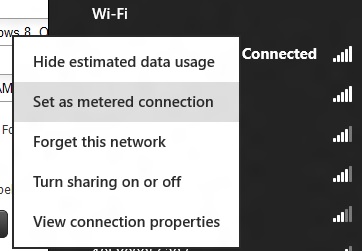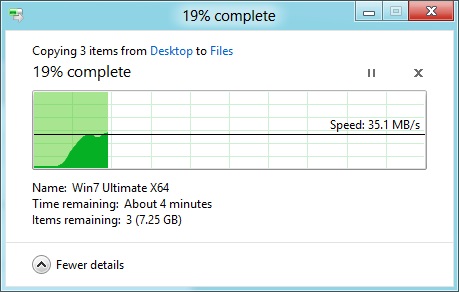In-Depth with the Windows 8 Consumer Preview
by Andrew Cunningham, Ryan Smith, Kristian Vättö & Jarred Walton on March 9, 2012 10:30 AM EST- Posted in
- Microsoft
- Operating Systems
- Windows
- Windows 8
Networking improvements
The widespread adoption of cellular connectivity in an increasing number of laptops and tablets have made our computing devices more mobile than ever before, but it has also given rise to an age of data caps, bandwidth throttling, and exorbitant prices from carriers. In the United States, unlimited data plans are a thing of the past, and as such any operating system worth its salt is going to have to be more careful about what, where, when, and how it sends and receives data.
To that end, Microsoft has instituted several features in Windows 8 that both users and developers can utilize to measure data usage and keep it in check.

Thanks to class drivers (which we'll discuss in just a minute), mobile broadband chips are treated as first-class devices in Windows 8—the same as wi-fi, ethernet, Bluetooth, and USB 3.0, among others—which means that broadband adapters can be turned on and off through the Windows GUI in the same way that wi-fi and Bluetooth now are, and there's also an Airplane Mode can turn all of it off in one swoop, just like on a smartphone (see above). As on phones, Windows will automatically prioritize wi-fi networks when both wi-fi and cellular are available.
This increased integration into Windows has many benefits: if your laptop or tablet has a SIM card installed, Windows can automatically detect which carrier it's associated with and download any available mobile broadband app from the Windows store, and carrier-unlocked laptops and tablets can choose between multiple cellular carriers if the hardware supports it. Windows also offers estimated data usage figures when connected to cellular networks, and when connected to a cellular network the OS will adjust its default behaviors to conserve bandwidth (for example, deferring the automatic downloading and installation of Windows updates until wi-fi is available).

Though it is off by default, these bandwidth conservation features can also be enabled for traditional wired and wireless network connections by right-clicking the name of the network you're connected to. While on a metered network, apps can now use new APIs to force network-aware Metro apps to use less data when possible (another example: using a low-bandwidth movie stream rather than a high bandwidth one). Network-aware Metro apps are required to use these APIs, and users can check how much bandwidth apps are using (both on metered and non-metered networks) in the new Task Manager.
Improvements to networking in Windows also extend to file copying, namely the SMB networked file sharing protocol. In Windows 8, the protocol can now shift dynamically between different network adapters during copy operations so that it always uses the fastest possible connection to transfer files. To demonstrate, I began copying a few gigabytes of data to a fileserver on my home network using a slow wireless G connection:

Then, without pausing the file copy operation or disabling my wireless card, I plugged the laptop into the network with a gigabit ethernet cable:

As you can see, as soon as Windows detected a faster network interface, it without complaint began copying the files using the faster connection. I then unplugged the laptop from the ethernet cable:

Again without issue, it switched back to the slower connection and continued copying the files. While this flexibility is impressive, it should be noted that it can only kick in for file transfers between two Windows 8 (or Windows Server 8) computers.
Drivers
Windows Vista broke a lot of things when it launched, and drivers was a big one—at least part of Vista’s caustic reputation was earned because third-party drivers made the platform so unstable. Since then, Microsoft has been committed to maintaining driver compatibility between Windows versions. During my testing, I found that the vast majority of drivers certified for Windows Vista and Windows 7 worked without issue in Windows 8, lending credence to Microsoft’s assertion that Windows 8 will be able to run on anything that could run Windows 7.
Windows 8’s main innovation is the sheer number of class drivers it introduces. For the un-indoctrinated, class drivers target defined specifications rather than specific hardware. Class drivers are the reason you don’t need to install specific software to run things like mice, keyboards, or USB 2.0 controllers.
Windows 8 adds new class drivers for things like USB 3.0 controllers, printers, motion sensors, mobile broadband cards, and a few others, all of which should be very useful on modern systems running Windows 8 or Windows on ARM. My personal experience extends to the USB 3.0 driver, which worked just fine for the oddball Fresco controller in my Intel desktop board, and the printer drivers, which worked well for a variety of local and networked printers I connected to from my various Windows 8 testbeds.
Microsoft also provides a new basic display driver in Windows 8. While the old generic display driver ran using the Aero Basic theme, the new driver appears to have basic support for Aero effects and transparencies. Among the systems that I tested, only a few had GPU-specific graphics drivers that installed from the DVD. While this may not be true of the RTM version of Windows 8, it looks like Microsoft is scaling back on the number of included graphics drivers to save space—you’d best check Windows Update or your manufacturer’s web site for updated graphics drivers, if they’re not included.










286 Comments
View All Comments
WPLJ42 - Friday, March 9, 2012 - link
The price was right on an HP AIO with an ULV CPU. Even with a 1.6 GHz CPU, the fan runs too much. About W8. Both the Developer and Consumer versions crashed and burned. After a few days, my PC went into a constant loop of rebooting. With the Consumer version, I was careful not to let Windows Update install any hardware drivers. I was using a dual boot with Windows 7. With both W8DP and W8CP, if I shut the computer down with Windows 8, it would boot itself in the dark of night. I am not an IT guy, just a run of the mill user. I had no issues with Windows 7 Beta, but it was running on an iMac with either VirtualBox or BootCamp, and it had to be the 32-bit version. I would like to know if my probably is an AMD thing, or HP, or if it is just me.Hulk - Friday, March 9, 2012 - link
As the author posted the Windows XP OS was getting long in tooth for me as I wanted to upgrade to 64bit OS and apps. Now that I'm there with Windows 7 I have absolutely no reason to upgrade to Windows 8. Actually since I'm sure we'll still be using 64bit applications in Windows 9 it might be a VERY long time before I move from Windows 7. I stayed with XP 9 years and if we were still 32 bit I have a feeling I'd still be using it.Good luck MS. But I'm fairly confident you're going down the wrong path on this one. 99.9% of desktop PC's are not touch screens. It doesn't make sense to alienate those users to "future-proof" yourself.
I bet they will reverse course on this in Windows 9.
hrmes09 - Friday, March 9, 2012 - link
Having used Windows 8 preview has made me so angry that I registered to Anandtech just to post this!I can't believe that MS is trying to shove all this down our throat!
Metro looks childish on a desktop computer and feels awkward. It's also the least intuitive gui that I have ever used!
If they continue down that road Windows 8 is going to be Microsoft's Itanium.
glugglug - Friday, March 9, 2012 - link
The Storage Spaces feature is truly awesome for us.hechacker1 - Friday, March 9, 2012 - link
I think that's probably my favorite Windows 8 feature.I just wonder how it compares to Intel raid, or other hardware raid. Frankly, Intel RAID is ok, but RAID5 write performance drops off a cliff.
Benchmarks Anandtech?
What I don't like is that it's probably impossible to access this from any other operating system if you happen to dual boot. At least Intel's and most other RAID5 implementations are accessible.
Oh, and the NTFS deduplication sound interesting too. Although you don't get to use it on ReFS AFAIK.
rburnham - Friday, March 9, 2012 - link
Great article! My only disappointment was not seeing the new OS installed on a Windows tablet, like the Acer Iconia.Zaranthos - Friday, March 9, 2012 - link
Where's my regular start menu? Quick launch (yeah I hate pinned icons)? Regular desktop icons? I spent a couple hours using Windows hate (8), went to bed mad, got up mad, told some of my friends how much Windows 8 sucked, and haven't used it since. My keyboard and mouse serve a purpose and Metro made them seem nearly useless. Windows 8 might be my new Vista/ME. I'd throw all the other improvements into the garbage can if they're tied to Metro.dchinu - Friday, March 9, 2012 - link
Its so dmn dumb argument "In fact they’re not disabling anything that hasn’t already been disabled on most competing tablets."Its like saying I am not the only one look at him, he's too a bedwetter
fisherg - Friday, March 9, 2012 - link
I believe it takes 3 mouse clicks to shut down Win 8. How many for Win 7? My XP machine is 3hrmes09 - Friday, March 9, 2012 - link
2 mouse clicks for Win 7. Also fewer miles moving the mouse around...